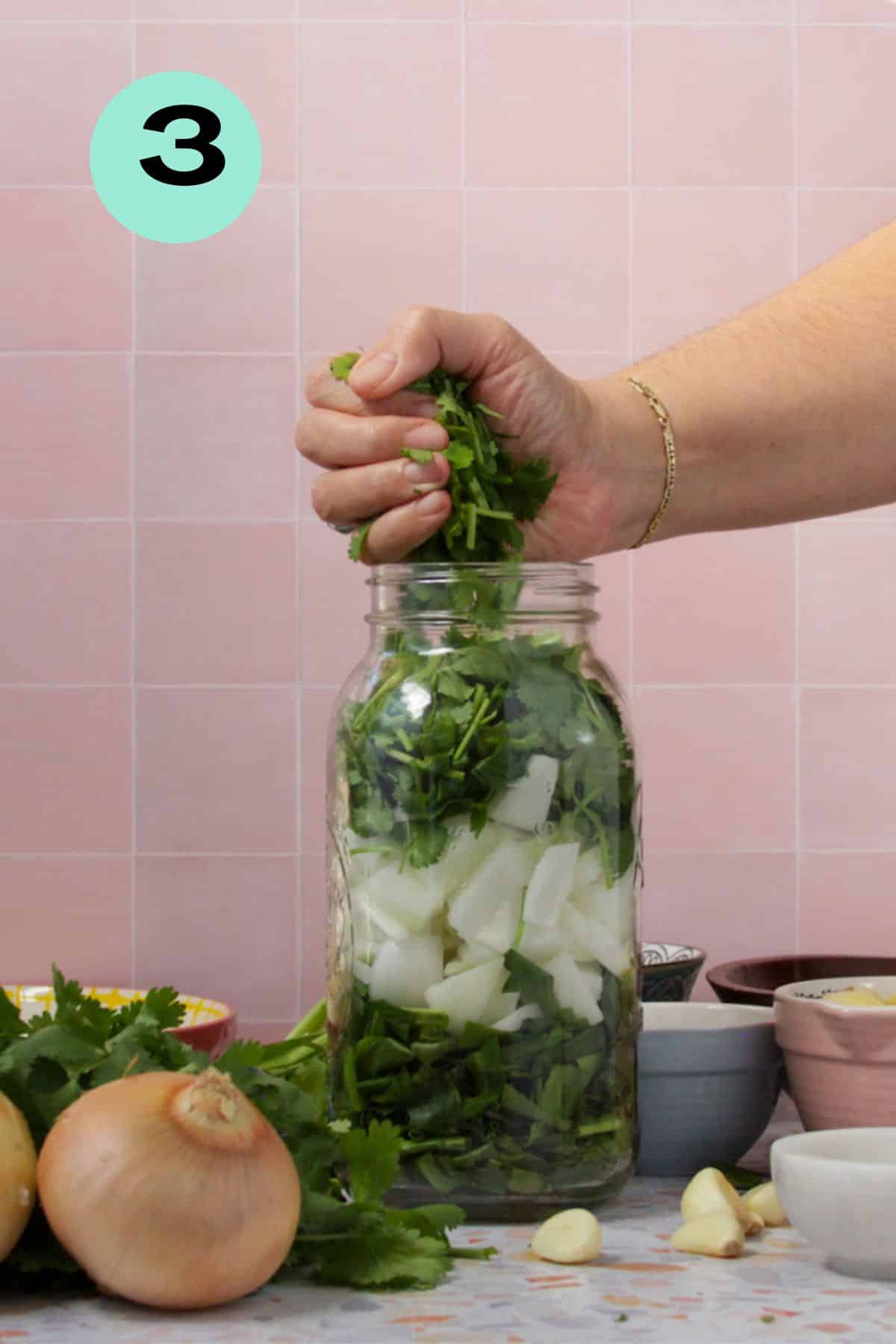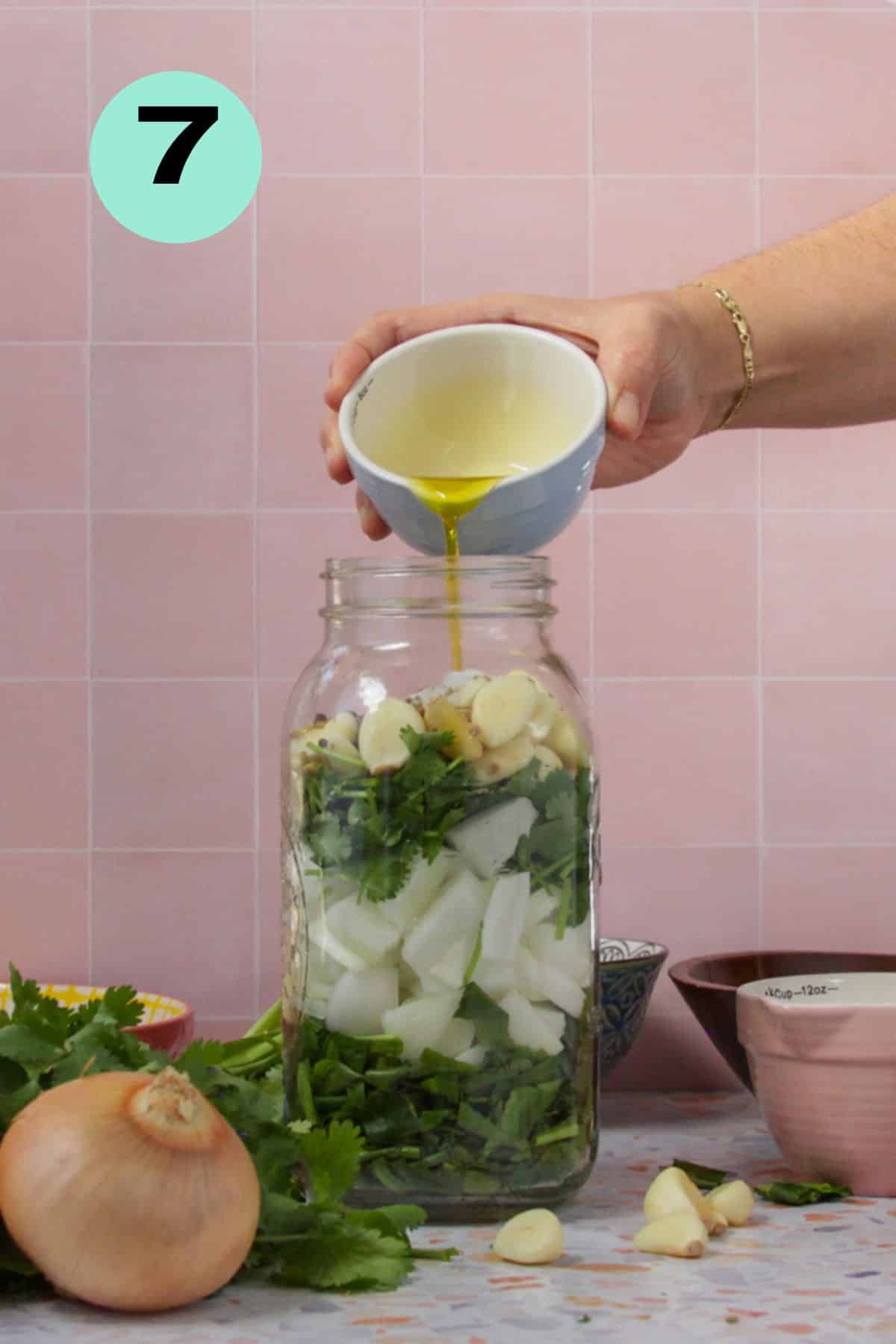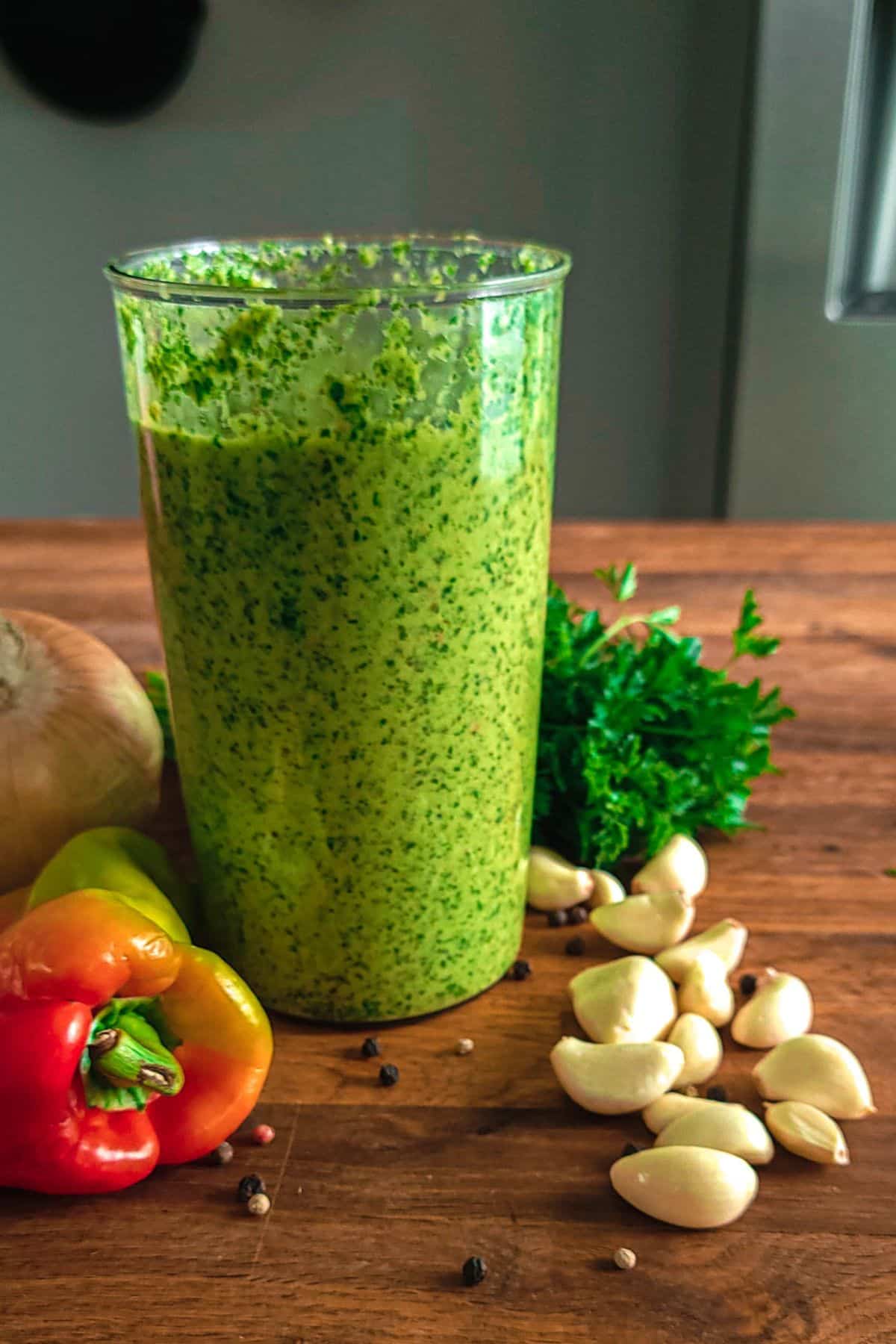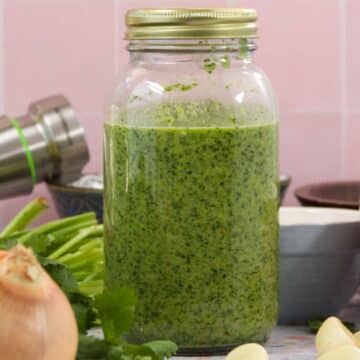Sofrito: Puerto Rico's culinary magic, always spicing things up and bringing flavors together in every dish! 🌶️🍲
Sofrito, a versatile condiment for beans and sauces, has found its way into various dishes. Other Puerto Rican seasonings include Adobo (for meat seasoning), Mojo (marinade for seafood, pork, chicken, and beef), and Achiote oil (which adds color and smoky flavor to rice and other dishes in which it is used).
If you are looking for more recipes in which to use this delicious flavor bomb, well, you are only limited by your imagination, lol. However, try sofrito when making Habichuelas Guisadas, Frijoles Negros, my version of Seafood Pomodoro, Arroz Con Pollo, and Picadillo.
Jump To
Traditional Sofrito
Because Sofrito is a combination of aromatic vegetables and herbs used to season while in the process of cooking many of the native Puerto Rican dishes, in theory, sofrito will be the very first set of ingredients to any recipe. Many Puerto Ricans opt to combine the ingredients in a blender and store under refrigeration in a jar or in ice cubes in the freezer.
One onion, one green pepper (seeded), three sweet chili peppers (seeded), three leaves of culantro, two cloves of garlic (peeled), and one-quarter teaspoon of dried oregano is all the ingredients you would need to make a traditional sofrito. However, finding the sweet chili peppers have been quite difficult for me here in the United States. These pepper resemble the Scott’s Bonnet pepper which stands opposite in levels of heat. I have found the peppers, but the store had misidentified them at times, to a spicy surprise for me when I went to eat my food.
Why this recipe works
- A Springboard: Like many recipes, this recipe provides a basis for learning what goes into a recipe, allowing you to learn how to substitute and adjust the recipe to your needs and taste. Not one of my friends makes the same sofrito because we don't all share the same tastes and likes.
- A tie to Tradition: Whether you follow the traditional recipe above or the one I make for my household, both are a tie to Puerto Rican culture and cuisine.
- Flavor Explosion: As the ingredients meld in the jar, their flavors intensify, making just one tablespoon sufficient to season stews, soups, or sauces.
Ingredient Notes
Remember, this is my personal Sofrito recipe. If you want to add peppers or other herbs, please do so. Just follow the ingredient list from the Traditional Sofrito section above. Those ingredients will make enough sofrito for any recipe that serves 6 to 8 people.

- Culantro: Recao as it is called in the island is related to Cilantro but its flavor and aroma tend to be stronger and more robust. This is the herb that without it you are officially not making sofrito. If you want to learn more about culantro SeriousEats.com has a great post dedicated to this delicious herb and how to use it.
- Onions: The number one aromatic vegetable in any cuisine. Almost every recipe begins with onions. Onions while raw have a bit of pep and spice, and once cooked they turn sugary sweet. This vegetable renders it’s flavors and disappears into the background.
- Garlic: Like onions many recipes cannot be without garlic, but it is not for everyone either. I personally would use three more cloves than any recipe calls for, only because I love garlic. Please use at your own discretion.
See my recipe card below for a complete list of the ingredients with measurements.
Variations and Substitutions
- Cubanelle Peppers: Cubanelle pepper is one of the few peppers, that my husband would eat. There is a sweetness and mildness in Cubanelle that we enjoy and we will use Cubanelle instead of bell peppers often. Chili Pepper Madness has a very informative post on Cubanelle peppers and how to use them if you are interested in learning more.
- Herbs: Substituting culantro will no longer make your sofrito Puerto Rican. I have given culantro to people who do find cilantro to be soapy and have not heard the same complaint. However, consider using parsley if you think this will be an issue. I have added parsley along with culantro and cilantro in the past to my sofrito and the result is quite delicious.
- Ham and Pork Fat: This might get argued, but if you were to go into any of Carmen Aboy Valldejuli's cookbooks (the Puerto Rican Julia Childs), mentions the use of pork and ham. These too are flavor agents for sofrito and many traditional recipes in Puerto Rico. The pork fat would be medium in which to render the flavors of your aromatics, while the ham adds a bit of smoke and flavor. Instead of ham, summer sausages can also be used.
How to Use Sofrito
Sofrito is a versatile cooking base used in many cuisines, particularly in Spanish, Latin American, and Caribbean cooking. Its main uses include:
- Flavoring: Sofrito adds depth, richness, and complexity to dishes, enhancing their overall flavor profile.
- Base for sauces and stews: It serves as the foundation for sauces, soups, and stews, such as paella, arroz con pollo, and picadillo.
- Marinades: Sofrito can be used as a marinade for meats, poultry, and seafood, infusing them with its aromatic flavors before cooking. I use Sofrito when cooking Pork chops, and Drunken Mussels.
- Rice dishes: It's commonly used in rice-based dishes like paella, arroz con pollo, and Rice and Beans and Arroz con Gandules (rice with pigeon peas) to impart flavor and color.
- Vegetable dishes: Sofrito can be added to vegetable dishes, such as sautéed or roasted vegetables, to enhance their taste.
How to make Sofrito
Here are the step-by-step instructions on how I make my Sofrito, but the process could be used for traditional sofrito as well.

- I do not have a blender, but an immersion blender. So I use a 64 oz mason jar when I make Sofrito. Start by layering the culantro.

- Followed by the rough chopped onion.

- Add cilantro. These ingredients can be added, blended, and then added more if your receptacle is not big enough.

- Add garlic cloves.

- Add spices: Salt, peppercorns, and oregano. Feel free to use ground pepper if you do not have peppercorns. Peppercorns will grind in different sizes and textures and would sit well in the sofrito marinating.

- Add cumin and coriander.

- Add Oil. I do not add a lot of oil, just enough to keep things flowing and as a mild preservative. The oil blends and binds all the ingredients together.

- Blend ingredients until all the big pieces are gone.

Expert Tips
- Make it your own: Cooking is a great way to pass down family history and traditions, but allow yourself the opportunity to make this or any other recipe your own. Use the ingredients you love, not just because a recipe deems it so, but also because these ingredients bring you joy and excitement to eat the food you prepared.
- Ground Peppercorns vs Whole: If you are using ground peppercorns in this recipe, consider using half the amount of peppercorns as required. Only because ground peppercorns have a more immediate stronger flavor. Using whole peppercorns allows for the seeds to crush at different sizes which will impart their flavor at different rates.
- Storage: I keep my Sofrito in a jar in the refrigerator. I use it in almost all my cooking, and I never freeze it. However, if you think you are not going to go through your sofrito as fast, pour one to two tablespoons into the cubes of an ice tray. Freeze, then remove from mold and bag in a freezer zip closure bag.
Recipe FAQs
Sofrito is a blended combination of key ingredients to give your food a signature Puerto Rican flavor. At its most basic, it is a mix of onions, garlic, peppers, sweet peppers, culantro, cilantro, and pepper. Other ingredients that could be found in sofrito may include; ham, salt pork, parsley, oregano, cumin, coriander, paprika, saffron, lemon, vinegar, and salt. The individual taste of the person making it means that not all sofrito taste the same. This list is based on conversations with friends and family of different ages and areas of the island.
Culantro is a much deeper-flavored cousin of cilantro. The leaves are long and saw-shaped. I have replaced culantro with cilantro before. But remember that cilantro has a much sweeter taste than culantro. So, it is not an exact replacement, more like a 1 part culantro for two-part cilantro. Culantro can be found at Latin markets or under specialty items in the produce department of major supermarkets. For more information on culantro visit Serious Eats.
There are many ways to use sofrito. Add sofrito to sauces, stewed beans, rice pilaf, and soups and stews in the middle of the cooking process. Or use sofrito as a seasoning agent or as a marinade. I have used it on chicken, shrimp, pork, and fish with excellent results. To turn it into a marinade for lighter meats, I will add a liquid, i.e., bitter orange, lemon, or regular orange juice.
You can fill ice cubes with sofrito and use a cube per recipe. I keep my sofrito in a mason jar, and I use it almost daily.

More Puerto Rican Inspirations Recipes
I want to know what you think! Did you make this recipe? Please leave a review and a rating below. You can also find me on Instagram! Please sign up for my email list to receive my newest and latest recipes.
📖 Recipe

Sofrito
Equipment
- Immersion Blender
Ingredients
- 3 ounces peeled garlic
- 2 teaspoons dried orégano
- 1 onion peeled, and large diced
- 1 bunch cilantro
- 4 fresh culantro leaves
- 1 teaspoon peppercorn
- 2 teaspoons salt
- ¼ cup olive oil
Instructions
- I do not have a blender, but an immersion blender. So I use a 64 oz mason jar when I make Sofrito. Start by layering the culantro.
- Followed by the rough chopped onion.
- Add cilantro. These ingredients can be added, blended, and then added more if your receptacle is not big enough.
- Add garlic cloves.
- Add spices: Salt, peppercorns, and oregano. Feel free to use ground pepper if you do not have peppercorns. Peppercorns will grind in different sizes and textures and would sit well in the sofrito marinating.
- Add cumin and coriander.
- Add Oil. I do not add a lot of oil, just enough to keep things flowing and as a mild preservative. The oil blends and binds all the ingredients together.
- Blend ingredients until all the big pieces are gone.






Comments
No Comments